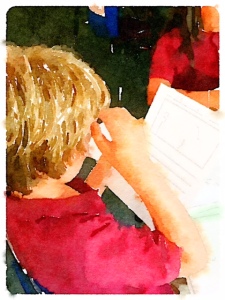On Friday night I listened to Salman Rushdie speak about being a writer. At one point, I found myself thinking about Kate DiCamillo. How did my brain wander from Salman Rushdie to Kate DiCamillo? Read on, I can explain.
Earlier this week I was reading reflections written by fourth graders, about their writing over time. Students looked through folders with works saved from the beginning, middle and end of every year they’ve been at our school. They finished statements using this form.
Their reflections helped them think about writing goals for this year and gave me ideas for future minilessons.
Some of their statements also gave me pause.
As I look back at my writing, I notice…
“I didn’t have as good handwriting or spelling.” Malcolm
“I wrote uppercase letters in random spots in words.” Justin
“that the farther in I get, the handwriting and spelling gets a lot better. I’m happy about that because it means that I am improving as a writer.” Sofia
Sofia, Justin, and Malcolm write well. And yes, their handwriting and spelling have improved. Yet, their words left me wondering what I can do to help them develop their identity as writers, so that when they look back and forward, they think that growing as a writer is about more than improved spelling and handwriting.
We teach our students about process, conventions, and craft moves, and we study and write pieces in different genres. We introduce them to notebook keeping and peer conferring. But perhaps the most important thing is to help young writers develop writer identities. No, they won’t all become published authors. But I’m pretty sure that not a one will even consider it without a writer identity. I’m also confident that developing writer identity is key to growing as a writer.
Enter Kate DiCamillo and Salman Rushdie. As different as they and their work are, I noticed when I listened to each of them speak (one last March, and the other on Friday night) that their writer identity is strong and clear, and they are in some ways remarkably similar. I noticed many of these things when I heard Jon Scieszka last spring and Lois Lowry a few years ago.
What do I mean?
- Writers are keenly interested in the world around them. People, events, and everyday happenings.
- Writers live reflective lives. They ponder the things that happen to and around them.
- Writers have interests beyond writing. (Kate loves dogs. Rushdie mentioned enjoying tennis and opera.)
- Many writers seem to have had a moment when they were so moved by something they read, that they thought “I want to do that.”
- Writers seem to know how to laugh at themselves and with others. (I must admit to being surprised by how funny Salman Rushdie was.)
- Writers understand their strengths and weaknesses.
- Writers are interested in other writers. They read their work, and know what they like and don’t like.
So how can we help our students develop their writer identities?
We can bring published writers to our writers by:
- sharing their writing stories, not just their books. Many author websites are full of interesting facts about how they became writers.
- searching and sharing YouTube videos of writers being interviewed.
- encouraging students to write to authors with questions about being writers. A few years ago my fourth graders wrote to Cynthia Lord after reading Rules. She wrote back, answering one question from each student in her letter.
- finding writers who offer free Skype sessions and setting those up with our class.
We can also help our writers develop their writer identities by:
- giving them time to reflect on their own writing- discovering their strengths, weaknesses, and patterns.
- exposing them to as much variety of writing and as many writers as possible.
- creating writing communities where writers feel safe to take risks, make mistakes, celebrate, and laugh.
- modeling living full and curious lives ourselves.
Writer identity may be the most important thing we cultivate in our students.




A lovely, thoughtful post. But what about the kids who really don’t identify as writers, and perhaps never will. I know many grownups who feel that way and I don’t think it’s because of their teachers or how they were taught writing. Some of it has to do with personality, and we must take that into consideration as well. So, having said that, how do we accommodate these non-writers by choice? I know that kids grow and change and adapt, but still some choose not to write!
LikeLike
This is a good post for all writers – I love your lists about writers identity and what we can do to help our students. It is good for us as adult writers to remember theses as well. With a bit of tweaking this is what all writers do – read other authors, listen to author interviews, reflect on our own writing, read a wide variety of genres and live full and curious lives. Thanks so much – a great post!
LikeLike
I absolutely agree with that last statement. Love this and will also be saving for later! Thanks for some great insights.
LikeLike
Lisa, I totally agree! I am saving this post. I have an upcoming workshop on how blogging helps students develop their identity as writers. I also feel like there are many teachers/ educators who quickly say they are not writers. I think this is a problem!
LikeLike